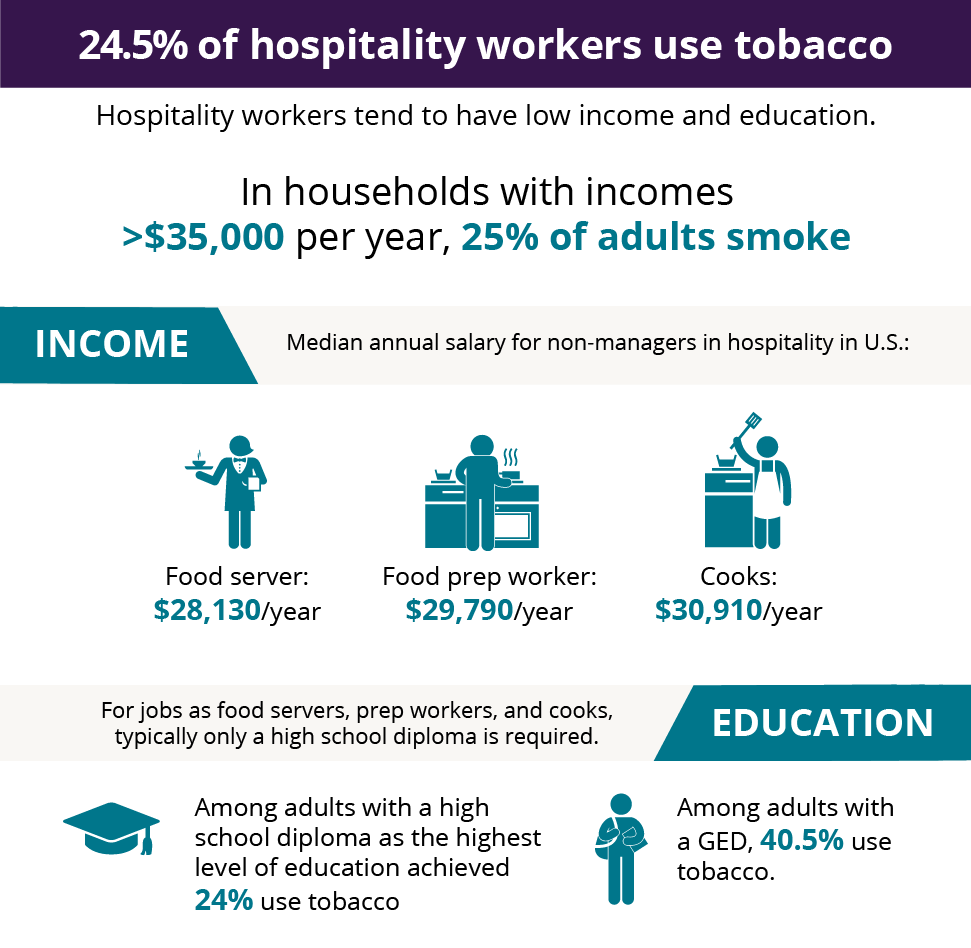With a 24.5% tobacco use rate, the hospitality industry has one of the largest populations of smokers in the U.S. (and likely the most smoke breaks at work, too).
Many experts speculate that it’s because many of workers in this industry are lower-income and have less education.
In households with an income of less than $35,000 per year, 25% of adults smoke. Meanwhile, median annual salaries for non-managers in the hospitality industry fall into these income ranges:
- Food server: $28,130
- Food prep worker: $29,790
- Cooks: $30,910
When it comes to education, the statistics are similar. Tobacco use is higher among adults who have fewer years of education. Of adults who use tobacco, 24% hold a high school diploma, but no degree. Education requirements for food servers, for example, typically only require a high school diploma.
But income and education aren’t the only factors in play for high tobacco use in hospitality. In these labor-intensive, high-stress jobs, many times there are other “benefits” for tobacco use that keep people addicted. And to help workers unhook from smoking and create a culture of health, employers need to address these issues, too.
More nicotine addiction, more smoke breaks at work
Despite smoke break guidelines set by restaurants and hotels, smokers may still take short, frequent breaks.
After a rush in a restaurant, for example, it’s common for cooking staff to go out for an after-service cigarette. When the choice for non-smokers is to join them or stay back and get a jump on cleaning the kitchen, it’s easy to see why some choose the less healthy route.
To further complicate things, among non-smokers, this inequity of breaks can cause resentment, as non-smokers may feel that smokers are using their addiction as an excuse to step out more. This can cause non-smokers to compensate by taking “important” cell phone calls or long bathroom breaks, hurting workplace productivity even further.
The bond of smoke breaks at work
With long hours, irregular shifts, and typically low pay, the hospitality industry’s need for continuous stress relief is deeply ingrained.
It’s no wonder that food and beverage top the list of industries in which employees felt the highest rates of work-related stress. (Read more about workplace stress and smoking in Care About Employee Mental Health? This Matters Too.) Smoke breaks become a way to bond with a coworker or a manager.
However, this form of socializing is not only unhealthy but also promotes addiction, especially in young adults that enter the hospitality workforce. These young adults may begin to smoke to be a part of the kitchen or hotel they consider their second home, further perpetuating nicotine addiction in your work environment.
Impact of smoking at work
It’s no secret that employees who use tobacco face a long list of costly health-related risks (cancer, COPD, heart disease). But higher healthcare costs and lower productivity are only 2 reasons to help hospitality workers quit tobacco.
Smoking also negatively affects companies in the hospitality sector by:
- Interfering with food workers’ ability to taste and smell—the senses that are at the heart of thoughtful food preparation. When served food tastes or smells gross, you can say goodbye to repeat customers.
- Creating food safety hazards and health risks if smokers forget to wash their hands. When smokers don’t wash their hands, contaminants from the smoke–which contains over 7,000 chemicals, including many carcinogens and other toxic chemicals–can find their way into the food. This not only ruins the taste; it adds unnecessary risk for customers.
- Generating a negative customer experience for those who balk at the smell of tobacco, around a hotel or restaurant facility or on waiter’s clothing in a restaurant.
How to help hospitality workers quit tobacco
To turn staff away from smoke breaks and transition your workplace into a more productive, tobacco-free environment, there are several critical steps you can take.
The first step is to create policies that set expectations for breaks and make it clear that smoke breaks are unacceptable at other times. I’d also recommend, for those in the restaurant industry, to implement new after-rush-hour traditions besides heading for smoke breaks.
The second step is to help workers both quit tobacco and deal with stress. EX Program, for example, provides live chat coaching so employees can receive support with coping strategies from an expert coach on a break. Our program also gives tobacco users 24/7 access to a thriving community of peers and tailored on-demand text messaging that can be used before or after a shift.
The third step is to provide workers with free, easy access to quit medication. Using quit medication can increase the likelihood of quitting. By removing barriers to access it, you give more workers the chance to use it and improve their chances of successfully quitting. Knowing this, the EX Program delivers free quit medication right to participants’ homes.
Interested in learning more about things to look for when purchasing a tobacco cessation program for your unique population? Download the Buyer’s Guide for Workplace Smoking Cessation Programs now.



